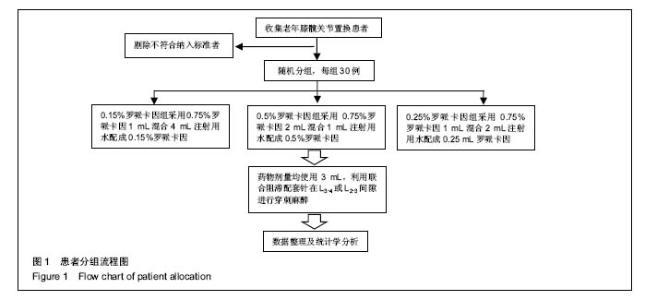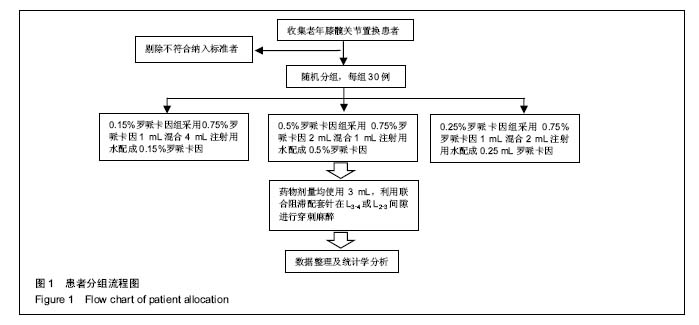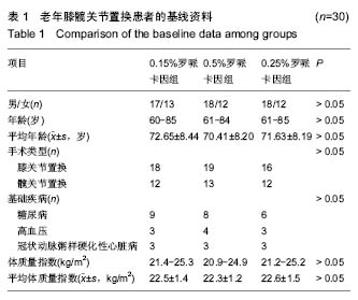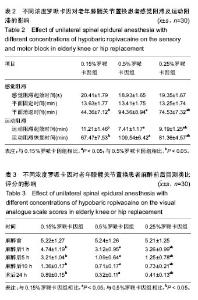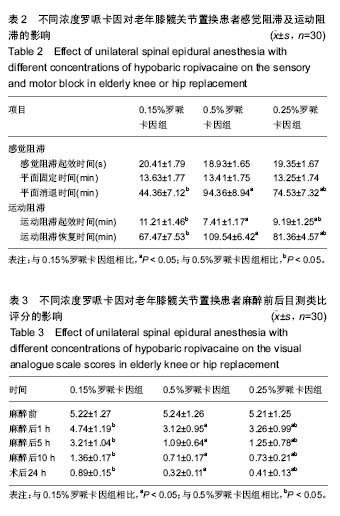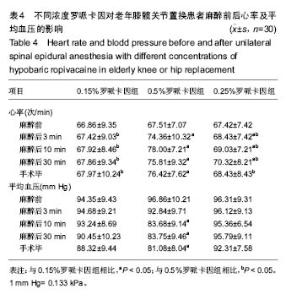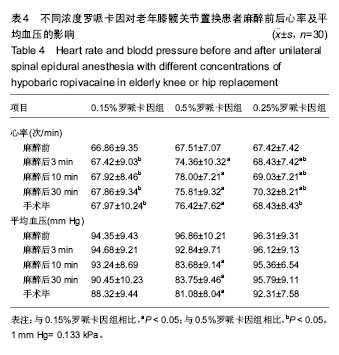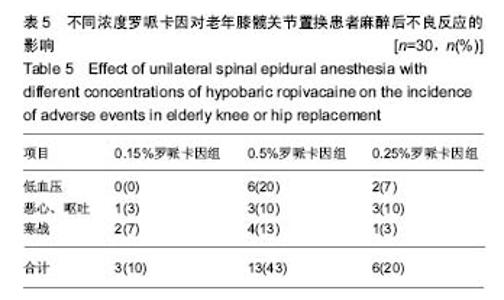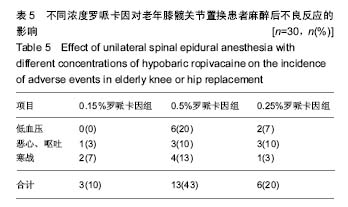| [1] Affas F, Eksborg S, Wretenberg P, et al. Plasma concentration of ketorolac after local infiltration analgesia in hip arthroplasty. Acta Anaesthesiol Scand. 2014;58(9):1140-1145. [2] Affas F, Eksborg S, Wretenberg P, et al. Ropivacaine pharmacokinetics after local infiltration analgesia in hip arthroplasty. Anesth Analg. 2014;119(4):996-999. [3] 魏长娜,王琛,单海华,等.不同浓度罗哌卡因连续髂筋膜腔隙阻滞用于全髋关节置换术病人术后镇痛的效果[J].中华麻醉学杂志, 2014,34(4):412-414.[4] 付俊,肖昀,钟和英,等.轻比重罗哌卡因单侧连续腰麻用于老年患者全髋关节置换术[J].湖北医药学院学报, 2012,31(6): 489-491, 495.[5] Gill AM, Scott NB, Abbas M, et al. Ropivacaine plasma levels following local infiltration analgesia for primary total hip arthroplasty. Anaesthesia. 2014;69(4):368-373. [6] Zoric L, Cuvillon P, Alonso S, et al. Single-shot intraoperative local anaesthetic infiltration does not reduce morphine consumption after total hip arthroplasty: a double-blinded placebo-controlled randomized study. Br J Anaesth. 2014; 112(4):722-728. [7] 徐俊峰,林梅,谢颖祥.两种不同的麻醉方式用于老年全髋关节置换术患者术后麻醉恢复期效果对比[J].中国老年学杂志, 2014, 34(19):5461-5463.[8] Wilson SH, Auroux AS, Eloy JD, et al. Ropivacaine 0.1% versus 0.2% for continuous lumbar plexus nerve block infusions following total hip arthroplasty: a randomized, double blinded study. Pain Med. 2014;15(3):465-472.[9] 伊丁丁.两种浓度罗哌卡因复合异丙酚麻醉在肛肠手术中的应用效果[J].中国实用医刊,2015,11(13):55-56.[10] 韩汝芳,范志勇,詹兵皇,等.极低浓度罗哌卡因复合舒芬太尼在可行走分娩镇痛中的临床研究[J].中外医学研究,2015,22(21):5-7.[11] 李友青.高龄股骨颈头下型骨折患者半髋置换术罗哌卡因复合芬太尼应用观察[J].浙江中西医结合杂志,2015,11(5):471-473.[12] 陈东晓,焦国华,吕圣琦,等.罗哌卡因在分娩镇痛应用中的疗效观察[J].浙江临床医学,2015,9(6):1024-1025.[13] Abbas M, Ahmad L, Shah Y, et al. Development of a method to measure free and bound ropivacaine in human plasma using equilibrium dialysis and hydrophilic interaction chromatography coupled to high resolution mass spectrometry. Talanta. 2013;117:60-63.[14] 杨万福,魏青.小剂量舒芬太尼复合罗哌卡因在轻度妊高症产妇分娩镇痛中的应用与药理分析[J].安徽医药, 2015,19(8):1608- 1611.[15] 杨家道,谭燕萍,秦用华,等.舒芬太尼复合罗哌卡因与芬太尼复合罗哌卡因在分娩镇痛临床应用中的比较[J].中国现代医学杂志, 2015,25(10):102-105.[16] Solovyova O, Lewis CG, Abrams JH, et al. Local infiltration analgesia followed by continuous infusion of local anesthetic solution for total hip arthroplasty: a prospective, randomized, double-blind, placebo-controlled study. J Bone Joint Surg Am. 2013;95(21):1935-1941. [17] Pandazi A, Kanellopoulos I, Kalimeris K, et al. Periarticular infiltration for pain relief after total hip arthroplasty: a comparison with epidural and PCA analgesia. Arch Orthop Trauma Surg. 2013;133(11):1607-1612. [18] Kuchálik J, Granath B, Ljunggren A, et al. Postoperative pain relief after total hip arthroplasty: a randomized, double-blind comparison between intrathecal morphine and local infiltration analgesia. Br J Anaesth. 2013;111(5):793-799. [19] 赵文宝,万磊,李彦平,等.应用不同比重罗哌卡因单侧腰麻对下肢手术麻醉效果的比较性观察[J].临床和实验医学杂志, 2014, 13(11):934-937. [20] den Hartog YM, Mathijssen NM, van Dasselaar NT, et al. No effect of the infiltration of local anaesthetic for total hip arthroplasty using an anterior approach: a randomised placebo controlled trial. Bone Joint J. 2015;97-B(6):734-740.[21] 王宇,朱云章,刘刚.高龄患者髋?膝关节置换中罗哌卡因腰椎硬膜外麻醉的镇痛效果[J].中国组织工程研究, 2015,19(13):1990- 1994.[22] 单海华,朱常花,谢红,等.超声引导下罗哌卡因连续股神经阻滞用于20例全膝关节置换术后康复镇痛的疗效分析[J].重庆医学, 2012,41(13):1312-1314.[23] 范丹,冀承杰,徐广民,等.连续股神经阻滞复合局部浸润麻醉对老年患者全膝关节置换手术术后的镇痛效果和应激反应的影响[J]. 四川医学,2016,37(7):709-713 .[24] 李蕊.罗哌卡因腰-硬联合麻醉在高龄患者髋部及下肢骨科手术中的应用[J].中华实用诊断与治疗杂志,2013,27(1):72-73.[25] 梁多芳,张宜金,刘庆,等.地佐辛用于剖宫产术后静脉镇痛300例临床效果评价[J].现代生物医学进展,2013,13(23):4499-4502.[26] Vora KS, Shah VR, Patel B, et al. Postoperative analgesia with epidural opioids after cesarean section: Comparison of sufentanil, morphine and sufentanil-morphine combination. J Anaesthesiol Clin Pharmacol. 2012;28(4):491-495. [27] Stroumpoulis K, Stamatakis E, Koutroumanis P, et al. Pencil-point needle bevel direction influences ED50 of isobaric ropivacaine with fentanyl in spinal anesthesia for cesarean delivery: a prospective, double-blind sequential allocation study. Int J Obstet Anesth. 2015;24(3):225-229. [28] 邓一午,文春艳.小剂量布比卡因腰硬联合麻醉与罗哌卡因硬膜外麻醉对老年人麻醉效果比较[J].中国医学工程,2014,22(3):52.[29] Bharti N, Praveen R, Bala I. A dose-response study of caudal dexmedetomidine with ropivacaine in pediatric day care patients undergoing lower abdominal and perineal surgeries: a randomized controlled trial. Paediatr Anaesth. 2014;24(11): 1158-1163.[30] 王玺,余湘元,朱建华,等.不同麻醉方法对老年患者人工髋关节置换手术后认知功能的影响[J].医学临床研究, 2014,31(1):115- 117. |
